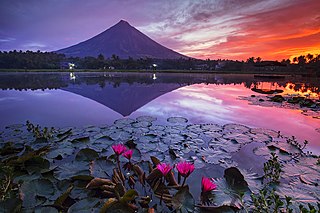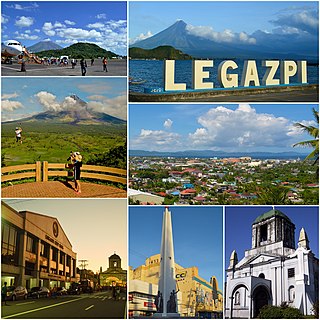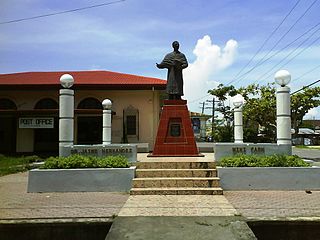
Albay, officially the Province of Albay, is a province in the Bicol Region of the Philippines, mostly on the southeastern part of the island of Luzon. Its capital is the city of Legazpi, the regional center of the whole Bicol Region, which is located in the southern foothill of Mayon Volcano.

Sorsogon, officially the Province of Sorsogon, is a province in the Philippines located in the Bicol Region. It is the southernmost province in Luzon and is subdivided into fourteen municipalities (towns) and one city. Its capital is Sorsogon City and borders the province of Albay to the north.

The Bicol Region, commonly shortened to Bicol and designated as Region V, is an administrative region of the Philippines. Also referred to as Bicolandia, it comprises six provinces, four on the Bicol Peninsula : Albay, Camarines Norte, Camarines Sur, and Sorsogon, and two off the shore: Catanduanes and Masbate.

Camarines Sur, officially the Province of Camarines Sur, is a province in the Philippines located in the Bicol Region on Luzon. Its capital is Pili and the province borders Camarines Norte and Quezon to the northwest, and Albay to the south. To the east lies the island province of Catanduanes across the Maqueda Channel.

Camarines Norte, officially the Province of Camarines Norte, is a province in the Philippines located in the Bicol Region in Luzon. Its capital is Daet. The province borders Quezon to the west, Camarines Sur to the south, and the Philippine Sea to the north. It has historically been a Bikol-speaking region. However, there has been a language shift in recent years to Tagalog, which is more commonly used nowadays.

Legazpi, officially the City of Legazpi, is a 1st class component city and capital of the province of Albay, Philippines. According to the 2020 census, it has a population of 209,533. Legazpi is the regional center and largest city of the Bicol Region, in terms of population. It is the region's center of tourism, education, health services, commerce and transportation in the Bicol Region.

Santo Domingo, officially the Municipality of Santo Domingo,, is a 4th class municipality in the province of Albay, Philippines. According to the 2020 census, it has a population of 37,765 people.

Magallanes, officially the Municipality of Magallanes, is a 2nd class municipality in the province of Sorsogon, Philippines. According to the 2020 census, it has a population of 37,411 people.

Philippine epic poetry is the body of epic poetry in Philippine literature. Filipino epic poetry is considered to be the highest point of development for Philippine folk literature, encompassing narratives that recount the adventures of tribal heroes. These epics are transmitted through oral tradition using a select group of singers and chanters.

Libmanan, officially the Municipality of Libmanan, is a 1st class municipality in the province of Camarines Sur, Philippines. According to the 2020 census, it has a population of 112,994 people. Libmanan is the largest municipality in Camarines Sur in terms of population, and the second largest in terms of land area.

Lupi, officially the Municipality of Lupi, is a 3rd class municipality in the province of Camarines Sur, Philippines. According to the 2020 census, it has a population of 33,897 people.

Ragay, officially the Municipality of Ragay, is a 1st class municipality in the province of Camarines Sur, Philippines. According to the 2020 census, it has a population of 59,770 people.

The Archdiocese of Cáceres is a Latin Church archdiocese of the Catholic Church in the Philippines. It is a metropolitan see that comprises the Bicol Region, while directly overseeing the third, fourth, and fifth congressional districts of Camarines Sur, Naga City, Iriga City and the Municipality of Gainza. The archdiocese, having been founded in 1595 in Nueva Cáceres, is also considered one of the oldest dioceses in the Philippines with Cebu, Segovia and Manila, and once had jurisdiction that stretched from Samar in the south and Isabela Province in the north. The seat of the archdiocese is currently located in Naga City, also known as the Queen City of Bicol.

The Bicolano people are the fourth-largest Filipino ethnolinguistic group. Their native region is commonly referred to as Bicolandia, which comprises the entirety of the Bicol Peninsula and neighboring minor islands, all in the southeast portion of Luzon. Males from the region are often referred to as Bicolano, while Bicolana may be used to refer to females.

Central Bikol, commonly called Bikol Naga or simply as Bikol, is an Austronesian language spoken by the Bicolanos, primarily in the Bicol Region of southern Luzon, Philippines. It is spoken in the northern and western part of Camarines Sur, second congressional district of Camarines Norte, eastern part of Albay, northeastern part of Sorsogon, San Pascual town in Masbate, and southwestern part of Catanduanes. Central Bikol speakers can be found in all provinces of Bicol and it is a majority language in Camarines Sur. The standard sprachraum form is based on the Canaman dialect.
The Ibalong Festival is a non-religious festival in Legazpi City, Albay, Philippines based on the Ibalong Epic, and is held on August. The festival celebrates the epic story Ibalong who was accompanied by three legendary heroes, namely Baltog, Handyong, and Bantong. People parade in the streets wearing masks and costumes to imitate the appearances of the heroes and the villains, portraying the classic battles that made their way into the history of Bicol. The Ibalong Festival aims to express warmth and goodwill to all people; visitors and tourists are encouraged to celebrate with the Bicolanos. The Ibalong Festival is also known as the Ibalon Waterfalls.
Jose Castaño was a Franciscan friar born in Hiniesta in the Province of Zamora, Spain. He took his vows as a Franciscan priest on May 2, 1874 and was sent to Manila on June 22, 1875.

The Bikol languages or Bicolano languages are a group of Central Philippine languages spoken mostly in the Bicol Peninsula in the island of Luzon, the neighboring island province of Catanduanes and the island of Burias in Masbate.

The Ibálong, also known as Handiong or Handyong, is a 60-stanza fragment of a Bicolano full-length folk epic of the Bicol region of the Philippines, based on the Indian Hindu epics Ramayana and Mahabharata. The epic is said to have been narrated in verse form by a native poet called Kadunung.

Mount Bernacci, locally known as Tangcong Vaca and also known as Mount Hantik, is a mountain located in the province of Camarines Sur, on the island of Luzon in the Philippines. It has a elevation of 756 m (2,480 ft) above mean sea level. The mountain may be seen from numerous points along the Pan-Philippine Highway.

















